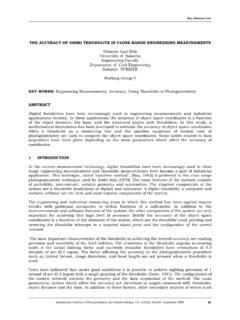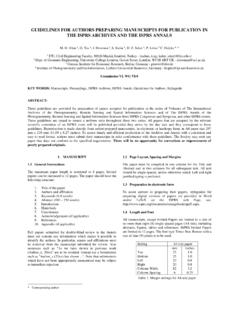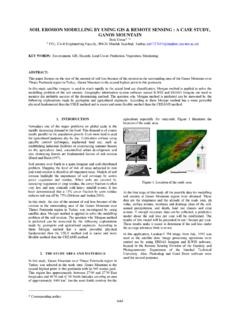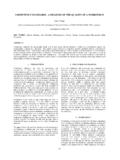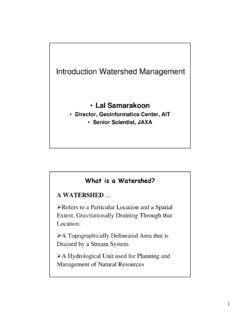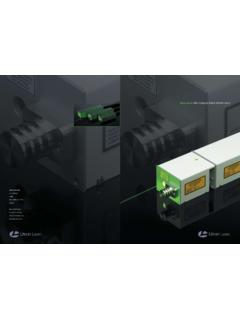Transcription of THERMAL REMOTE SENSING: CONCEPTS, ISSUES …
1 239 International Archives of Photogrammetry and REMOTE sensing . Vol. XXXIII, Part B1. Amsterdam REMOTE sensing : CONCEPTS, ISSUES AND APPLICATIONSA nupma PRAKASHITC, Geological Survey Group WG VII / 3 KEY WORDS: THERMAL infrared, radiant temperature, emissivity, black body, volcanoes, the last few decades REMOTE sensing has reached from an experimental to an operational level. The increase in thenumber of earth observation satellites, the advancement in tools and processing techniques, and the use of data for newapplications has been phenomenal. However, the major part of the efforts were directed in the past towards the use ofoptical data and now also to the use of microwave data. The available literature underlines the fact that the use of dataacquired in the THERMAL infrared region has been relatively limited within the scientific and application community.
2 Thelimited use of THERMAL data is linked to several facts such as the limitation of the sensor capabilities, the nature of dataitself, and the reluctance of many to explore the potentials of THERMAL REMOTE sensing . This paper deals with the conceptsand ISSUES of THERMAL REMOTE sensing and presents a variety of applications where THERMAL data finds its way. Thebenefits and limitations of THERMAL data are discussed and the potential of THERMAL REMOTE sensing , specially in light offuture high resolution satellites, is highlighted. The paper concludes with the author's views on the importance of theseaspects specially in the standard REMOTE sensing educational INTRODUCTIONT hermal REMOTE sensing is the branch of REMOTE sensing that deals with the acquisition, processing and interpretation ofdata acquired primarily in the THERMAL infrared (TIR) region of the electromagnetic (EM) spectrum.
3 In THERMAL remotesensing we measure the radiations 'emitted' from the surface of the target, as opposed to optical REMOTE sensing wherewe measure the radiations 'reflected' by the target under consideration. Useful reviews on THERMAL REMOTE sensing aregiven by Kahle (1980), Sabins (1996) and Gupta (1991)It is a well known fact that all natural targets reflect as well as emit radiations. In the TIR region of the EM spectrum,the radiations emitted by the earth due to its THERMAL state are far more intense than the solar reflected radiations andtherefore, sensors operating in this wavelength region primarily detect THERMAL radiative properties of the groundmaterial. However, as also discussed later in this article, very high temperature bodies also emit substantial radiations atshorter wavelengths. As THERMAL REMOTE sensing deals with the measurement of emitted radiations, for high temperaturephenomenon, the realm of THERMAL REMOTE sensing broadens to encompass not only the TIR but also the short waveinfrared (SWIR), near infrared (NIR) and in extreme cases even the visible region of the EM REMOTE sensing , in principle, is different from REMOTE sensing in the optical and microwave region.
4 In practice, THERMAL data prove to be complementary to other REMOTE sensing data. Thus, though still not fully explored, thermalremote sensing reserves potentials for a variety of applications . The next sections discuss the main concepts and issuesof THERMAL REMOTE sensing and continue to present a brief overview of the application of THERMAL data. The articleconcludes with the advantages and limitations of THERMAL REMOTE sensing and the need for including this topic in remotesensing educational CONCEPTSIn THERMAL REMOTE sensing , radiations emitted by ground objects are measured for temperature estimation. Thesemeasurements give the radiant temperature of a body which depends on two factors - kinetic temperature andemissivity. Figure 1 presents the various factors affecting the radiant temperature and these are further discussed inAnupma Prakash240 International Archives of Photogrammetry and REMOTE sensing .
5 Vol. XXXIII, Part B1. Amsterdam Subsection presents the concept and measurement of radiant temperature which is the basis efestimating radiant temperature from THERMAL REMOTE sensing data. However, before presenting these CONCEPTS, subsection briefly discusses the wavelength ranges which are of interest for THERMAL REMOTE 1. Factors controlling radiant Wavelength / Spectral RangeThe infrared portion of the electromagnetic spectrum is usually considered to be from to 1,000 m. Within thisinfrared portion, there are various nomenclatures and little consensus among various groups to define the sub-boundaries. In terrestrial REMOTE sensing the region of 3 to 35 m is popularly called THERMAL -infrared. As in all otherremote sensing missions, data acquisitions are made only in regions of least spectral absorption known as theatmospheric windows.
6 Within the THERMAL infrared an excellent atmospheric window lies between 8-14 m windows lie in 3-5 m and 17-25 m. Interpretation of the data in 3-5 m is complicated due to overlap withsolar reflection in day imagery and 17-25 m region is still not well investigated. Thus 8-14 m region has been ofgreatest interest for THERMAL REMOTE Emissivity and Kinetic TemperatureThermal REMOTE sensing exploits the fact that everything above absolute zero (0 K or C or 459 F) emitsradiation in the infrared range of the electromagnetic spectrum. How much energy is radiated, and at whichwavelengths, depends on the emissivity of the surface and on its kinetic temperature. Emissivity is the emitting abilityof a real material compared to that of a black body (see ), and is a spectral property that varies with composition ofmaterial and geometric configuration of the surface.
7 Emissivity denoted by epsilon ( ) is a ratio and varies between 0and 1. For most natural materials, it ranges between and Kinetic temperature is the surface temperature of abody/ground and is a measure of the amount of heat energy contained in it (see ) . It is measured in different units,such as in Kelvin (K); degrees Centigrade ( C); degrees Fahrenheit ( F). Black body is a theoretical object that absorbs and then emits all incident energy at all wavelengths. This meansthat the emissivity of such an object is by definition 1. Needless to say, such an object is only imaginary and no naturalsubstance is an ideal black Factors Affecting the Kinetic Temperature can be categorised in two broad groups - heat energy budget andthermal properties of the materials (figure 1). Heat energy budget includes factors such as solar heating, longwaveupwelling and downwelling radiations, heat transfer at the earth-atmosphere interface and active THERMAL sources suchas fires, volcanoes etc.
8 THERMAL properties of material include factors such as THERMAL conductivity, specific heat,RADIANT TEMPERATUREE missivityKinetictemperatureHeat budgetSolar heatingLongwave upwellingradiationDownwellingradiationAn omalousheat sourcesThermal propertiesThermal conductivitySpecific heatHeat capacityThermal diffusivityThermal inertiaSolar elevationCloud coverAtmosphericconditionsTopographicalt itudeAnupma Prakash241 International Archives of Photogrammetry and REMOTE sensing . Vol. XXXIII, Part B1. Amsterdam , heat capacity, THERMAL diffusivity and THERMAL inertia of the material. An excellent explanation of these factorsis given by Kahle (1980). TemperatureThe radiant temperature (TR) is the actual temperature obtained in a REMOTE sensing measurement and, as mentionedearlier, depends on actual or kinetic temperature (TK) of the body and the its emissivity ( ).
9 The total radiations emittedby non black body (natural surfaces) is given by44 RKTTW = =sse(1)where is the Stefan-Boltzmann's constant. This defines the relation between the radiant temperature and kinetictemperature of a body asKRTT =41e(2)From the above equation, and the knowledge that all natural materials are non-black bodies with emissivity less thanone, it is clear that the radiant temperature (temperature estimated by REMOTE sensing data) is always less than the actualsurface temperature of the body by a factor total amount of radiations emitted by a body can also be estimated using Planck' equation which gives:llleelp = 11252 TkchchW(3)where lWis the spectral emittance, h is the Planck's constant ( Js), c is the speed of light (-18ms 103 ), l isthe wavelengtn metres, k is Boltzmann's constant (-123JK ), T is the temperature in K and leis the formula also implies that with the rise in temperature of the ground objects, there is an increase in the intensity ofthe emitted radiations, with the peak shifting towards shorter wavelengths.
10 Inverting Planck's equation we get + = 1ln 512lllelWCCT(4)where -2161 = =chCp and mK = converting digital values from REMOTE sensing data to spectral radiance and to radiant temperatures the reader isreferred to the paper by Markham and Barker (1986) as well as Prakash and Gupta (1998).3 ISSUESDue to the fundamental difference between REMOTE sensing in the THERMAL infrared region and the other regions of theEM spectrum, there are some ISSUES peculiar and pertinent for THERMAL REMOTE sensing . Some of these relate to the modeof acquisition, calibration, radiometric and geometric correction, and are discussed in the following Data acquisition: Modes and platformsThere are three different aspects which must be considered while talking about the mode of THERMAL data areAnupma Prakash242 International Archives of Photogrammetry and REMOTE sensing .
